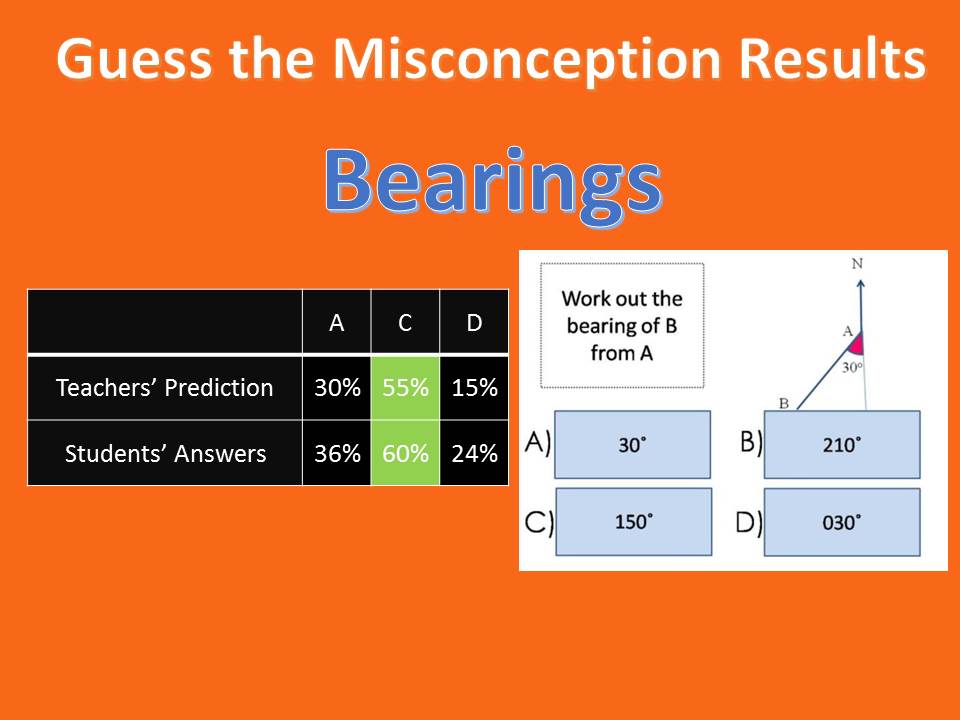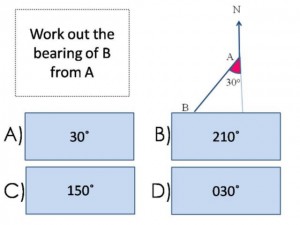Bearings are the kind of topic that students cannot bear (sorry). The tend to sneak their way into several key topics, most notably angle facts, construction and trigonometry. Hence, if a student’s understanding of bearings is dodgy, then it could jeopardise their chances of success across other areas.
This question is one of the most poorly answered across the free daily GCSE Revision Stream to date, with over half of students getting the answer wrong. Let’s take a look at the question, and see the kind of misconceptions that it reveals:
As predicted by teachers, by far the most popular incorrect answer was C). Why would students go for an answer of 150 degrees? Their explanations are incredibly revealing, suggesting varying levels of understanding of angles, but with once again the common thread being students falling flat due to a misremembered or misunderstood rule for bearings:
“this is because angles on a straight line equal to 180 so we take (180 away from 30) which gives us 150”
“Since the angle in the triangle is 30 degrees. I cant measure the bearing of b from a physically. Because, i know that angles on a straight line add up to 180 degrees. I use this understanding to figure out that the bearing is 150 degrees(0150 degrees)”
“Starting clockwise from north, the angle has to be 360 all the way around. 180 is already shown add the 30 degrees. 180+30=210 360-210= 150 degrees from B to A”
“Bearings always go clockwise, and angles on a straight line add up to 180 degrees. So 180 – 30 will give you the bearing from A to B which is 150 degrees”
It is interesting to note that the answer of 30 degrees cropped up in both answer A) and D), which together accounted for just as many wrong answers as C alone. Where does 30 degrees come from, I hear you ask. Well, in the words of students across the world:
“because it needs to be from north so you put the north line there, this creates a z shape. This means alternate angles are equal”
“Angle on a straight line is 180 and add 30 to find the bearing”
“180 – 30 = 150 150 + 180 = 330 360 – 330 = 30”
“Bearings always have three digits and the angles are on the same line.”
And my personal favourite: “HAVEN’T GOT A CLUE ABOUT BEARINGS MISS!!”
Like the rest of the country, over half our students got this bearings question wrong. How will we deal with this? Well, each week in our Monday Maths Departmental meeting, we discuss a particularly poorly answered question from the free daily GCSE Revision Stream that all our Year 11s complete. We then show this question to each of our Year 11 classes and discuss not only the correct answer, but some of the best ways of explaining the answer, as well as the reasons behind the wrong answers. Doing this on a regular basis (we hope!), will allow us to focus on the areas that our students need help with in an efficient way, and through discussions lead to a deeper understanding of potentially troublesome topics.


You mean cannot *bear*
Which makes your pun better, too! 😉
I have been teaching bearing for the last 15+ years and i’ve met lot many students with a multitude of misconceptions. with experience i’ve devised ways for teching same and till date, many students have seen light through this chapter all by using a simple technique which involves certain mandatory steps only to ‘cheat’ any misconception that wants to seep into the solution for a given question. Amazingly, students of form 1 have been able to do questions on Bearing that they are supposed to do in form 2, i.e they did same a year before (accelerated learning + content acceleration) It has worked wonders. I’m most willing to share my teaching tips for maths classroom HACKS. plese advise how to do so.
—- KAVIRAJ SHEORAJ (MAUTITIUS)
“THE MORE YOU SHARE, THE MORE YOU GET”
Sounds fascinating! Feel free to drop me an email. Craig
Fixed now. Great spot!